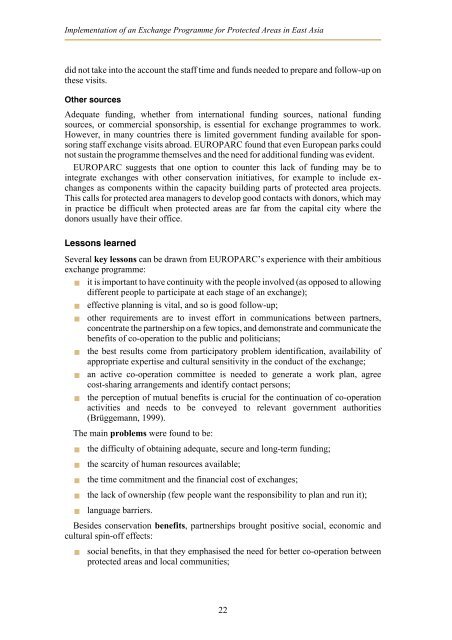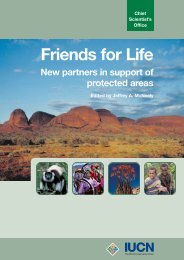Exchange programmes - IUCN
Exchange programmes - IUCN
Exchange programmes - IUCN
Create successful ePaper yourself
Turn your PDF publications into a flip-book with our unique Google optimized e-Paper software.
Implementation of an <strong>Exchange</strong> Programme for Protected Areas in East Asia<br />
did not take into the account the staff time and funds needed to prepare and follow-up on<br />
these visits.<br />
Other sources<br />
Adequate funding, whether from international funding sources, national funding<br />
sources, or commercial sponsorship, is essential for exchange <strong>programmes</strong> to work.<br />
However, in many countries there is limited government funding available for sponsoringstaff<br />
exchange visits abroad. EUROPARC found that even European parks could<br />
not sustain the programme themselves and the need for additional funding was evident.<br />
EUROPARC suggests that one option to counter this lack of funding may be to<br />
integrate exchanges with other conservation initiatives, for example to include exchanges<br />
as components within the capacity building parts of protected area projects.<br />
This calls for protected area managers to develop good contacts with donors, which may<br />
in practice be difficult when protected areas are far from the capital city where the<br />
donors usually have their office.<br />
Lessons learned<br />
Several key lessons can be drawn from EUROPARC’s experience with their ambitious<br />
exchange programme:<br />
� it is important to have continuity with the people involved (as opposed to allowing<br />
different people to participate at each stage of an exchange);<br />
� effective planningis vital, and so is good follow-up;<br />
� other requirements are to invest effort in communications between partners,<br />
concentrate the partnership on a few topics, and demonstrate and communicate the<br />
benefits of co-operation to the public and politicians;<br />
� the best results come from participatory problem identification, availability of<br />
appropriate expertise and cultural sensitivity in the conduct of the exchange;<br />
� an active co-operation committee is needed to generate a work plan, agree<br />
cost-sharingarrangements and identify contact persons;<br />
� the perception of mutual benefits is crucial for the continuation of co-operation<br />
activities and needs to be conveyed to relevant government authorities<br />
(Brüggemann, 1999).<br />
The main problems were found to be:<br />
� the difficulty of obtaining adequate, secure and long-term funding;<br />
� the scarcity of human resources available;<br />
� the time commitment and the financial cost of exchanges;<br />
� the lack of ownership (few people want the responsibility to plan and run it);<br />
� language barriers.<br />
Besides conservation benefits, partnerships brought positive social, economic and<br />
cultural spin-off effects:<br />
� social benefits, in that they emphasised the need for better co-operation between<br />
protected areas and local communities;<br />
22






